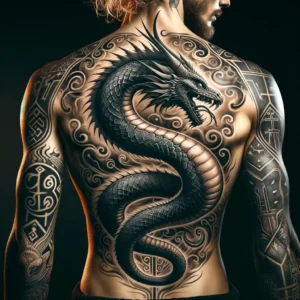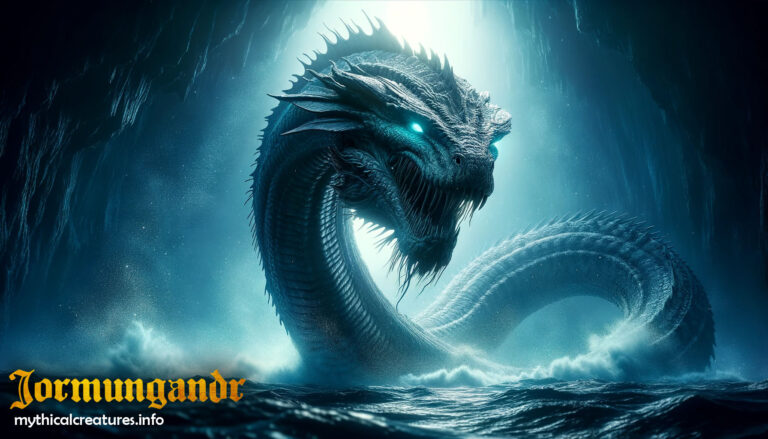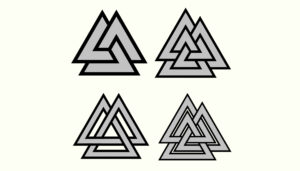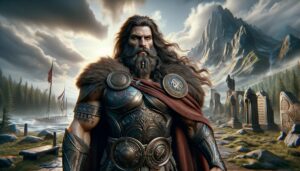Table of Contents
Jormungandr, often referred to as the Midgard Serpent or World Serpent, is a prominent figure in Norse mythology. It is a giant sea serpent or dragon that encircles the Earth, biting its own tail. Jormungandr is one of the three children of the trickster god Loki and the giantess Angrboða, the other two being the wolf Fenrir and the half-dead, half-living Hel.
In Norse mythology, Jormungandr’s appearance in the form of a massive serpent symbolizes chaos and destruction. According to prophecies, during Ragnarök, the cataclysmic event that signifies the end of the world, Jormungandr will rise from the depths of the ocean to engage in a climactic battle with Thor, the god of thunder. This battle will result in both Thor and Jormungandr perishing.
Appearance
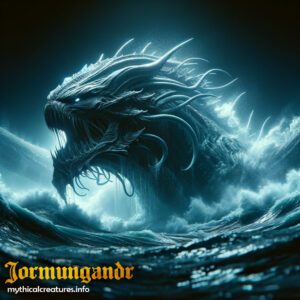
Jormungandr possesses the following characteristics in terms of its physical description:
Immense Size: Jormungandr is an extraordinarily large sea serpent, described as so enormous that it encircles the entire Earth.
Serpentine Form: Its body takes on the form of a long, winding serpent or dragon, characterized by scales that glisten like burnished metal.
Endless Length: The serpent’s length is said to be so great that it can coil around the world, biting its own tail, forming a continuous circle.
Monstrous Appearance: Jormungandr’s monstrous visage includes sharp fangs and a menacing, reptilian gaze, befitting its role as a symbol of chaos and destruction.
Symbol of Ragnarök: As a key participant in the apocalyptic events of Ragnarök, Jormungandr’s appearance underscores the cataclysmic nature of this mythological event in Norse lore.
Mythological Significance: Its physical form represents the cosmic forces and impending doom that are central to the narrative of Norse mythology.
Characteristics
Destructive Nature: Jormungandr is a harbinger of chaos and doom. Its emergence during Ragnarök signifies the end of the world and the destruction of the existing order.
Fear-Inducing: The serpent’s presence invokes fear and apprehension among both gods and humans, as its actions are linked to the impending cataclysmic events.
Tenacity: Jormungandr’s relentless nature is evident in its ability to encircle the Earth and maintain its existence until the prophesied final battle with Thor.
Symbolism: Beyond any personal traits, Jormungandr symbolizes the forces of nature and the cyclical nature of creation, destruction, and renewal in Norse mythology.
Family
Jormungandr belongs to a family consisting of the trickster god Loki and the giantess Angrboða. Loki and Angrboða have three children, including Jormungandr. These offspring also include the wolf Fenrir and the half-dead, half-living Hel. This family of mythical beings plays pivotal roles in Norse mythology, representing chaos and the impending doom of Ragnarök, the apocalyptic event in Norse cosmology.
Stories about Jormungand
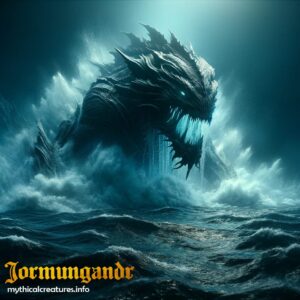
The Fishing Trip
Long ago, in the land of the Norse gods, a brave and adventurous fisherman named Erik lived. He was renowned throughout the village for his extraordinary fishing skills. One day, he chose to embark on the most daring fishing trip of his life.
Erik had heard tales of the legendary Midgard Serpent, Jormungandr, said to reside in the ocean depths, encircling the world. Rumors claimed the serpent’s size was so immense it could devour entire ships.
While others warned against such folly, Erik’s curiosity and courage drove him forward.
He spent days preparing his boat, ensuring it was sturdy enough to withstand any challenges the ocean might present. Armed with a massive fishing rod and a heart full of determination, Erik set sail into the unknown waters of the North Sea.
Days turned into weeks as Erik journeyed further and further from the safety of the shore. He faced fierce storms, treacherous waves, and biting cold, but his resolve never wavered. He knew that if he could capture the Midgard Serpent, his name would be etched in history.
Then, one fateful day, it happened. Erik felt a tremendous tug on his line, the likes of which he had never experienced. With all his strength, he began to reel in his catch, determined to face whatever lay beneath the surface.
As the massive creature emerged from the depths, Erik’s heart pounded with a mixture of fear and awe. Before him, coiled like a mountainous mass of dark scales, was Jormungandr, the Midgard Serpent. It glared at Erik with its piercing, reptilian eyes.
Erik knew he had but one chance. With every ounce of his strength, he pulled the serpent closer and closer to his boat. As he did, he felt the world around him tremble, for the serpent’s movements were so powerful that they shook the very Earth.
Finally, with a mighty effort, Erik hoisted the serpent onto his boat, its enormous body writhing and thrashing. He had done the impossible. The serpent’s struggles continued, but Erik, with sheer determination and courage, managed to subdue it.
News of Erik’s incredible feat spread like wildfire, and he returned to the village a hero. He became a legend, known as the fearless fisherman who had captured the Midgard Serpent. His name was celebrated for generations to come, a testament to the indomitable spirit of those who dare to chase their dreams, even in the face of the most colossal challenges.
Ragnarök
In the realm of Norse mythology, there existed a prophecy of an event known as Ragnarök, the final battle between the gods and the forces of chaos. At the heart of this cataclysmic event was the monstrous Midgard Serpent, Jormungandr.
As the days grew darker and the signs of Ragnarök began to manifest, the gods of Asgard, including mighty Thor, knew that their fate was sealed. The ancient prophecies had foretold the coming of this apocalyptic battle, and there was no avoiding it.
Jormungandr, the Midgard Serpent, was coiled at the bottom of the ocean, encircling the world in its eternal slumber. But as the time for Ragnarök drew near, it stirred from its deep rest, sensing the impending chaos. The serpent’s scales glimmered ominously as it prepared to rise and fulfill its role in this world-altering event.
On the day of Ragnarök, the sky darkened, and the ground trembled as the forces of chaos, led by the fierce wolf Fenrir and the half-dead, half-living ruler of the realm of the dead, Hel, emerged to challenge the gods. The final battle had begun.
Thor, the god of thunder, wielded his mighty hammer, Mjölnir, and faced Jormungandr, whose colossal form emerged from the ocean’s depths. The serpent’s massive body towered over the battlefield, and its eyes burned with malevolent fury.
Thor hurled Mjölnir with all his might, and the hammer clashed with the serpent’s scaly hide. Thunder roared and lightning crackled as the two titanic beings locked in a cataclysmic struggle. The earth shook beneath them, and waves rose to unfathomable heights.
The battle between Thor and Jormungandr raged on, each blow echoing through the cosmos. It was a battle of epic proportions, and the outcome hung in the balance. Thor fought valiantly, determined to vanquish the serpent and save what remained of the world.
But as the battle reached its climax, a fatal blow was struck. Jormungandr’s venomous fangs pierced Thor’s side, and the god of thunder staggered back, mortally wounded. Despite his incredible strength and courage, Thor had met his match.
As Jormungandr’s venom coursed through Thor’s veins, the world around them continued to crumble. The prophecies of Ragnarök were being fulfilled. The gods fell one by one, and chaos reigned supreme.
In the end, Jormungandr’s role as the harbinger of destruction had been fulfilled. The world was consumed by chaos and fire, and the cosmos descended into darkness.
Ragnarök had come to pass, and the Midgard Serpent, Jormungandr, had played its part in the twilight of the gods. The world, as it once was, had ceased to exist, leaving only a desolate and unrecognizable landscape in its wake, a testament to the inevitability of cosmic cycles in Norse mythology.
FAQ
What is the significance of Jormungandr in Norse mythology?
Jormungandr is a symbol of chaos and destruction. It plays a crucial role in the apocalyptic event known as Ragnarök, where it battles the god Thor.
Who are Jormungandr's parents and siblings?
Jormungandr's parents are the trickster god Loki and the giantess Angrboða. Its siblings include the wolf Fenrir and the half-dead, half-living ruler of the realm of the dead, Hel.
What is the story of Jormungandr's involvement in Ragnarök?
During Ragnarök, Jormungandr rises from the ocean to engage in a fierce battle with the god Thor. The battle results in both the serpent and Thor perishing, signifying the end of the world.
Is Jormungandr found in other mythologies or cultures?
Jormungandr is specific to Norse mythology and is not typically found in other mythological traditions.
What is the symbolism of Jormungandr in Norse mythology?
Jormungandr represents the cyclical nature of creation, destruction, and renewal in Norse cosmology. It embodies the forces of chaos and the inevitability of change.
How is Jormungandr described physically?
Jormungandr is described as an enormous sea serpent with scales and the ability to encircle the Earth. It has a monstrous appearance, including sharp fangs and a menacing gaze.
Are there any modern adaptations or references to Jormungandr?
Jormungandr continues to be a popular figure in literature, pop culture, and video games, often appearing as a formidable sea serpent or dragon.
Is there any historical evidence of belief in Jormungandr in ancient Norse society?
While there is no direct historical evidence of belief in Jormungandr, its role in Norse mythology is documented in ancient texts, such as the Poetic Edda and Prose Edda.
Jormungandr tatoo
